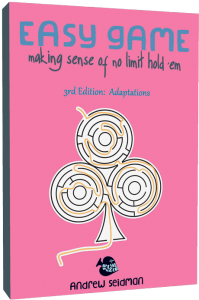The general problem with poker books that teach exploitive strategy is that they are easily dated. The once ground-breaking tactics outlined in Doyle Brunson’s Super/System no longer win big money now that the majority of poker players understand the logic behind fast-playing draws.
The recently released third edition of Andrew “BalugaWhale” Seidman’s Easy Game is a welcome response to this problem. Seidman not only updates his advice for contemporary game conditions but also corrects a few of his own earlier mistakes and re-explains some material in light of his current thinking about the game. The result is substantial value added to what was already an exceptionally good no-limit hold ’em cash game book, one of the few offering really high-level insights to experienced players.
is a welcome response to this problem. Seidman not only updates his advice for contemporary game conditions but also corrects a few of his own earlier mistakes and re-explains some material in light of his current thinking about the game. The result is substantial value added to what was already an exceptionally good no-limit hold ’em cash game book, one of the few offering really high-level insights to experienced players.
Although the first section of Easy Game is entitled “Basics”, this is not a book for beginners. The material is well-explained but far from easy and would almost certainly fly over the head of anyone remotely new to poker. This section might best be considered an introduction to advanced poker thinking for those who have already progressed beyond what they can find in mass-market books.
In what I can only assume is an attempt to render complex “basics” more comprehendable to these readers, Seidman actually oversimplifies central concepts like reasons for betting. The nit in me wanted to insert a series of objections and clarifications, but the pragmatist recognizes that this choice makes sense. There’s enough uncertainty and situational thinking in high-level poker that newcomers need some clear, actionable advice to anchor them as they find their way. It only gets more complicated from here.
Seidman warns as much, telling readers, “don’t expect a lot of math, but do expect intricate descriptions of difficult subjects.” This is fair warning to readers of this dense, fast-paced book. Even after mastering the “Basics”, readers will have to work hard to keep up with the “Advanced” section, which dives headfirst into the complexities of “Street Projection”, “Pseudo-Thin Value”, and “Showdown Theory”.
This is genuinely high-level stuff. I won’t claim mastery of everything, but it’s rare that I come across big no-limit hold ’em concepts that I’d never heard of or thought about myself. Easy Game contains several, including a very useful distinction between passive and aggressive dead money and some great insights into overbetting and underbetting, concepts on which I considered myself well ahead of the curve.
The other half of the author’s warning – “don’t expect a lot of math” – is the book’s only true weakness. Seidman’s explanation of why a certain play is profitable is rarely more than hand-waving in the direction of the math involved, most of which is not actually that complicated. He misdefines balance as betting an “equal number of value hands and bluffing hands” and is downright dismissive of Heads-Up Displays and their related statistics. It seems to be the case that Seidman himself has achieved great success without these tools, but writing them off as unimportant is dangerously naïve.
Aside from this and the author’s moderately irksome name-dropping of the well-known players with whom he’s played and exchanged ideas, there’s not a lot to complain about. Seidman writes smartly and succinctly, which makes for a dense but readable tome that’s 136 pages long in PDF form.
There’s no filler here. If anything, Seidman could be accused of writing too little on tough-to-understand concepts. Everything you need to understand it is there, but most of it requires multiple re-reads to grasp fully.
The unique format of this, which includes all of the original text plus new additions and commentary from the author, is itself a sort of rereading. The ways in which Seidman’s thinking has changed and developed is interesting in its own right, generating a value to the whole that is more than the sum of its parts.
Virtually any of the book’s fifty-two chapters could be improved with more examples, but Easy Game is already far longer than your average poker e-book, and it certainly would have been a shame if these examples came at the expense of additional new material. Moreover, the final chapter discusses twenty-seven example hands that tie together the book’s many concepts and demonstrate how they play out at the tables.
